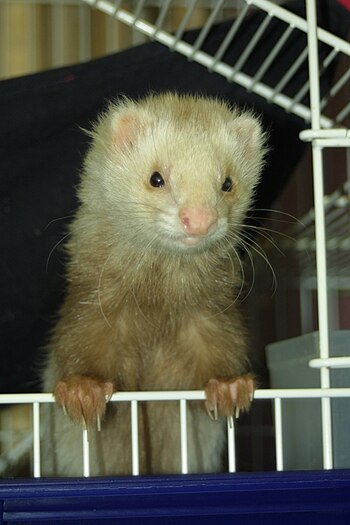 |
| An Angora Ferret “Ranko” (Photo credit: Wikipedia) |
The angora ferret, with its long fur and lively behavior makes an exotic and a very entertaining pet. Although more expensive than other kinds of ferrets, this beautiful and inquisitive creatures can fill your life with fun and laughter.
How did Angoras come into being?
They originated in Sweden, when a breeder noticed some changes in his ferrets. Certain mutations in the genetic level caused these ferrets to have longer hair in their hind legs and backsides. This breeder sold his special ferrets to another in Norway, who bred angoras, as we know them nowadays.
Angoras, with their particular coat color and hair length, are reared by repeated in breeding. Hence, some veterinarians prefer to group them as a subspecies.
How do these variants of ferrets differ from normal ferrets?
They differ in terms of looks as well as behavior. Fur of angoras is very long - perhaps the most distinguishing feature. However, do not mistake long haired ferrets for angoras - there are several other dissimilarities as well.
Body Structure - the trademark long fur can grow up to 4 inches in length. They can weigh up to 7 pounds. The tell-tale sign of an angora ferret is an extra fold on their pointed, slightly turned-up nose and a small tuft of hair on the tip or inside the nose. As very small kits, the angoras do not have long fur, but they can be recognized by their nose. The shape of the eyes also differs slightly from an American ferret.
Sparse hair on tails - this is because these ferrets have no undercoat. So even though the rest of their body is covered with luscious long hair, their tail appears to be bare. Due to the lack of undercoat, they do not shed as much as regular ferrets.
Much higher energy levels than American ferrets - angoras are cute, but also excessively inquisitive and can be stubborn as well. Before purchasing an angora, it would be helpful if you already have a full-grown well trained ferret at home. It can set an example of behavior for your new angora kit.
Sometimes angoras have a tendency to nip, so be cautious before letting a child handle them.
Clint is a ferret enthusiast who enjoys giving information about Angora Ferret [
Article Source: EzineArticles
|

No comments:
Post a Comment